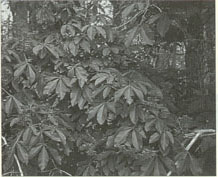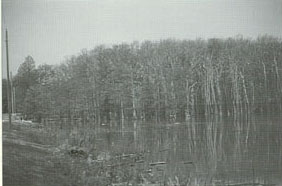
Left: Red buckeye trees signal springtime on Horseshoe Lake Island, part of the 9,550-acre Horseshoe Lake Conservation Area in Alexander County. Below: The high-water line from the flood of 1993 is clearly visible on trees near the causeway.
comprised of bare trunk, while the lighter upper areas have natural life and lichens. Although the flooding was devastating for the stand of tupelo trees, the cypress fared slightly better.
Natural mortality was taking its toll on the trees even before the flood, and a concern existed about the lack of natural cypress regeneration. Local residents, long accustomed to excellent fishing opportunities at the lake, were worried about the effect of siltation and the subsequent decline of the sport fishery. Department personnel were concerned about the loss of older trees in the lake and the lack of younger trees to take their place. The trees provide shading, which results in cooler water and more oxygen for the fish.
Recognizing the need for action, the Division of Forest Resources planned a pilot tree-planting project for the Miller City Arm, a shallow portion of the lake that is somewhat separated from other areas by a causeway. The Department began growing cypress and tupelo trees at its nurseries, and in 1996, as part of an experimental plot, approximately two dozen small trees were set out in the north end of the Miller City Arm. From this preliminary planting, forestry employees learned they needed to more securely anchor the trees to prevent them from moving before they had a chance to take root. Meanwhile, they continued to nurture hundreds of trees for a major planting in the future.
The cypress and tupelo trees at the nurseries were about five-feet tall in the fall of 1997 when an amazing thing happened. Just as Mother Nature had ravaged Horseshoe lake during the 1993 floods, she turned off her faucets, dried out what she had previously drowned, and offered what was thought to be a once-in-a-lifetime chance to plant hundreds of trees on a relatively dry lake bed. The trees were ready and a crew was quickly assembled.
For three consecutive days, 20 people joined forces to set out 750 trees. Since the lake bed was dry enough to be accessed via all-terrain vehicles, cypress and tupelo trees were bagged in burlap and loaded onto four-wheelers. The dry lake bed made it possible to place the trees, bag and all, on the ground and then securely stake them from both the top and bottom so they could have a chance to take root and flourish. The burlap bags would disintegrate with the passing of time.
"We planted an equal number of cypress and tupelo, trying to mimic the way they grow naturally," Stratton said. "If you look at the older trees out in the lake, you will notice they grow in clumps of five or six trees. fairly close together. Then, there will be 50 or 100 yards of open water. We tried to duplicate that placement.
Pirtle added that within a month, the lake was once again covered with water. "Even if the area had remained dry for an extended period of time, the trees would not have suffered because there is always water down in the soil to sustain them," he said. "Cypress and tupelo are adaptable to a wide range of sites and, in fact, grow even better on well-drained moist soil than in the water."
Both Stratton and Pirtle said the success of this project can be attributed to a real team effort. Employees from DNR's divisions of Wildlife Resources, Fisheries, Natural Heritage and Forestry were quick to offer a hand. Also assisting were staff from the Cypress Creek National Wildlife Refuge and The Nature Conservancy.
Division of Forestry's long-range plans call for additional cypress and tupelo plantings at the lake. Chances are good that those trees will be planted in standing water. That is unless Mother Nature dictates otherwise.
LIZ PENSONEAU
is a staff writer for Outdoor Illinois a publication of the Illinois Department of Natural Resources This article is reprinted with permission from the June 1998 issue of OutdoorIllinois Photographs by Liz Pensoneau
